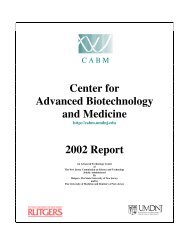Annual Report 2011 - Center for Advanced Biotechnology and ...
Annual Report 2011 - Center for Advanced Biotechnology and ...
Annual Report 2011 - Center for Advanced Biotechnology and ...
You also want an ePaper? Increase the reach of your titles
YUMPU automatically turns print PDFs into web optimized ePapers that Google loves.
polymerase II, facilitating the selective capping of pre-mRNAs. Similarly, the full<br />
length <strong>and</strong> C-terminal domain of CE were<br />
localized to the nucleus in transfected cells <strong>and</strong> also bound poly (U) in vitro,<br />
suggesting that the C-terminal domain of CE can bind nascent transcript 5' termini<br />
<strong>for</strong> capping directly. The CE N-terminal RNA 5'-triphosphatase (amino acids 1-<br />
237) contains the sequence VHCTHGFNRTG which corresponds to the<br />
conserved active-site motif in protein tyrosine phosphatases (PTPs). Mutational<br />
analyses identified the Cys <strong>and</strong> Arg residues in this motif <strong>and</strong> an upstream<br />
aspartate as required <strong>for</strong> triphosphatase activity. These <strong>and</strong> other results indicate<br />
that removal of phosphate from RNA 5' ends <strong>and</strong> from modified tyrosine residues<br />
in proteins occurs by a similar mechanism.<br />
We also cloned <strong>and</strong> characterized the third essential enzyme <strong>for</strong> mRNA 5'capping,<br />
human mRNA (guanine-7-) methyltransferase (MTase). It mapped to<br />
18p11.22-p11.23, a region encoding brain transcripts that have been suggested as<br />
positional c<strong>and</strong>idates <strong>for</strong> susceptibility to bipolar disorder. Sequence alignment of<br />
the 476-amino acid MTase protein within the corresponding yeast, C. elegans <strong>and</strong><br />
Drosophila enzymes demonstrated several required, conserved motifs including<br />
one <strong>for</strong> binding S-adenosylmethionine. MTase bound to human CE <strong>and</strong> also<br />
<strong>for</strong>med ternary complexes with the elongating <strong>for</strong>m of RNA polymerase II. To<br />
identify other proteins that interact with CEs, we used a yeast two-hybrid system<br />
to screen a human fetal brain cDNA library with full length human CE <strong>and</strong><br />
isolated transcription elongation factor SPT5. It bound to CE <strong>and</strong> stimulated RNA<br />
guanylylation but not the triphosphatase step of capping. Purified,<br />
hyperphosphorylated CTD similarly stimulated RNA guanylylation in vitro, but<br />
the effects of P-CTD <strong>and</strong> SPT5 were not additive, suggesting a common or<br />
overlapping binding site on CE. By using two-hybrid, GST-pulldown <strong>and</strong> coimmunoprecipitation<br />
approaches, we also found that MTase interacts with the<br />
nuclear transporter, importin-α (Impα). MTase selectively bound <strong>and</strong> methylated<br />
RNA containing 5'-terminal GpppG, <strong>and</strong> both activities were stimulated severalfold<br />
by Impα. MTase/RNA/Impα complexes were dissociated by addition of<br />
Impβ which also blocked Impα stimulation of RNA cap methylation. RanGTP but<br />
not RanGDP prevented these effects of Impβ. The results suggested that, in<br />
addition to a linkage between capping <strong>and</strong> transcription, mRNA biogenesis <strong>and</strong><br />
nucleocytoplasmic transport are functionally connected.<br />
A general model of capping: RNA Polymerase II containing hypophosphorylated<br />
CTD initiates transcription, produces 20-25 nucleotide 5'-triphosphorylated<br />
transcripts <strong>and</strong> pauses with SPT5 bound as part of a large transcription complex.<br />
Serine 5 residues in the heptad repeats that comprise the CTD <strong>and</strong> SPT5 are<br />
phosphorylated by transcription factor TFIIH, changing the CTD con<strong>for</strong>mation to<br />
allow CE binding. The 5’ end of the ~25 nucleotide nascent transcript is capped<br />
as it becomes exposed at the surface of the polymerase complex, stimulated by<br />
SPT5 as well as by the hyperphosphorylated CTD (P-CTD). MTase binds to CE<br />
(mammals) or to P-CTD (yeast). Impα stimulates MTase binding <strong>and</strong> N7 guanine<br />
methylation. After phosphorylation of SPT5 <strong>and</strong> RNA Polymerase II on CTD<br />
33



